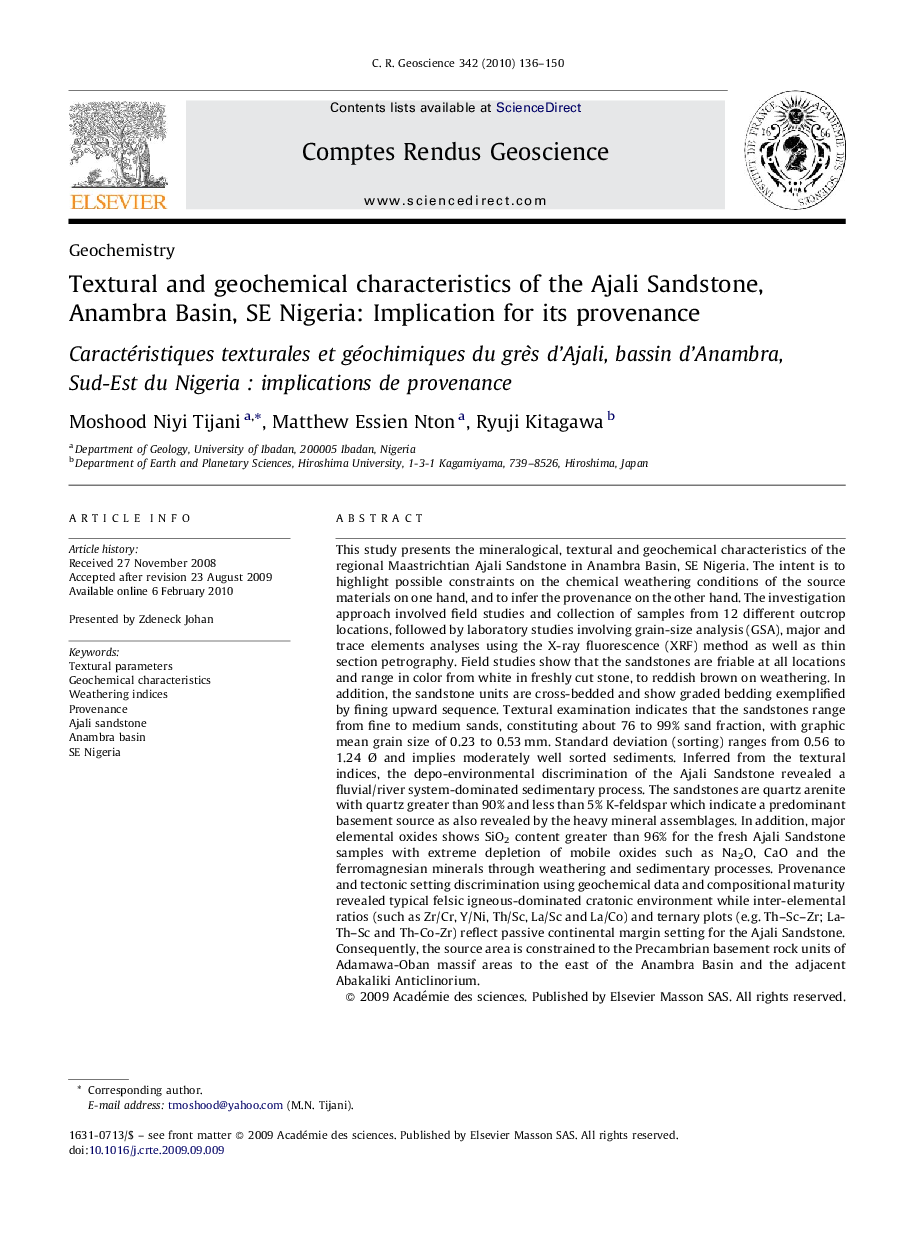| کد مقاله | کد نشریه | سال انتشار | مقاله انگلیسی | نسخه تمام متن |
|---|---|---|---|---|
| 4462510 | 1313504 | 2010 | 15 صفحه PDF | دانلود رایگان |

This study presents the mineralogical, textural and geochemical characteristics of the regional Maastrichtian Ajali Sandstone in Anambra Basin, SE Nigeria. The intent is to highlight possible constraints on the chemical weathering conditions of the source materials on one hand, and to infer the provenance on the other hand. The investigation approach involved field studies and collection of samples from 12 different outcrop locations, followed by laboratory studies involving grain-size analysis (GSA), major and trace elements analyses using the X-ray fluorescence (XRF) method as well as thin section petrography. Field studies show that the sandstones are friable at all locations and range in color from white in freshly cut stone, to reddish brown on weathering. In addition, the sandstone units are cross-bedded and show graded bedding exemplified by fining upward sequence. Textural examination indicates that the sandstones range from fine to medium sands, constituting about 76 to 99% sand fraction, with graphic mean grain size of 0.23 to 0.53 mm. Standard deviation (sorting) ranges from 0.56 to 1.24 Ø and implies moderately well sorted sediments. Inferred from the textural indices, the depo-environmental discrimination of the Ajali Sandstone revealed a fluvial/river system-dominated sedimentary process. The sandstones are quartz arenite with quartz greater than 90% and less than 5% K-feldspar which indicate a predominant basement source as also revealed by the heavy mineral assemblages. In addition, major elemental oxides shows SiO2 content greater than 96% for the fresh Ajali Sandstone samples with extreme depletion of mobile oxides such as Na2O, CaO and the ferromagnesian minerals through weathering and sedimentary processes. Provenance and tectonic setting discrimination using geochemical data and compositional maturity revealed typical felsic igneous-dominated cratonic environment while inter-elemental ratios (such as Zr/Cr, Y/Ni, Th/Sc, La/Sc and La/Co) and ternary plots (e.g. Th–Sc–Zr; La-Th–Sc and Th-Co-Zr) reflect passive continental margin setting for the Ajali Sandstone. Consequently, the source area is constrained to the Precambrian basement rock units of Adamawa-Oban massif areas to the east of the Anambra Basin and the adjacent Abakaliki Anticlinorium.
RésuméCette étude présente les caractéristiques minéralogiques, texturales et géochimiques du grès maastrichtien de la région d’Alali, bassin d’Anambra, Sud-Est Nigeria. Son but est de mettre en évidence les contraintes possibles, sur les conditions d’altération des matériaux source d’une part, et d’en inférer la provenance, d’autre part. La méthode d’approche comporte des études de terrain, la récolte d’échantillons à partir de 12 affleurements, suivies d’examens de laboratoire comportant analyse granulométrique, analyser des éléments majeurs et en traces utilisant la fluorescence X, analyse pétrographique sur lame mince. Les études de terrain montrent que le grès est friable sur tous les sites et que la couleur va du blanc sur la roche fraîche au brun rougeâtre sur les échantillons altérés. En outre, les formations présentes montrent stratification entrecroisée et granoclassement que la séquence fini-sommitale illustre particulièrement bien. Du point de vue textural, les grès se révèlent constitués de sables fins à moyens représentant 76 à 99 %, avec une taille de grain moyenne de 0,23 à 0,53 mm. La déviation standard (classement) est comprise entre 0,56 et 1,24 Ø et implique des sédiments modérément bien triés. Le grès d’Ajali révèle un mode de sédimentation dominé par un système fleuve/rivière. Les grès sont des arénites quartzeuses avec plus de 90 % de quartz et moins de 5 % de feldspath-K, ce qui indique une provenance prédominante du socle, comme l’indique l’assemblage de minéraux lourds. En outre, le contenu en oxydes d’éléments majeurs est de plus de 96 % de SiO2 pour le grès frais et on observe un extrême appauvrissement en oxydes mobiles tels Na2O et CaO et en ferromagnésiens au cours des processus d’altération et de sédimentation. La distinction entre provenance et mise en place tectonique d’après les données géochimiques et la maturité de composition révèle un environnement cratonique typique, dominé par les roches ignées, tandis que les rapports entre éléments tels que Zr/Cr, Y/Ni, Th/Sc, La/Sc et La/Co ou les points ternaires tels Th–Sc–Zr, La-Th–Sc et Th-Co-Zr reflètent la mise en place d’une marge continentale passive pour le grès d’Ajali. En conséquence, la région source est contrainte aux formations rocheuses du socle précambrien des zones du massif Adamawa-Oban à l’est du bassin d’Anambra et de l’anticlinorium d’Abakaliki.
Journal: Comptes Rendus Geoscience - Volume 342, Issue 2, February 2010, Pages 136–150